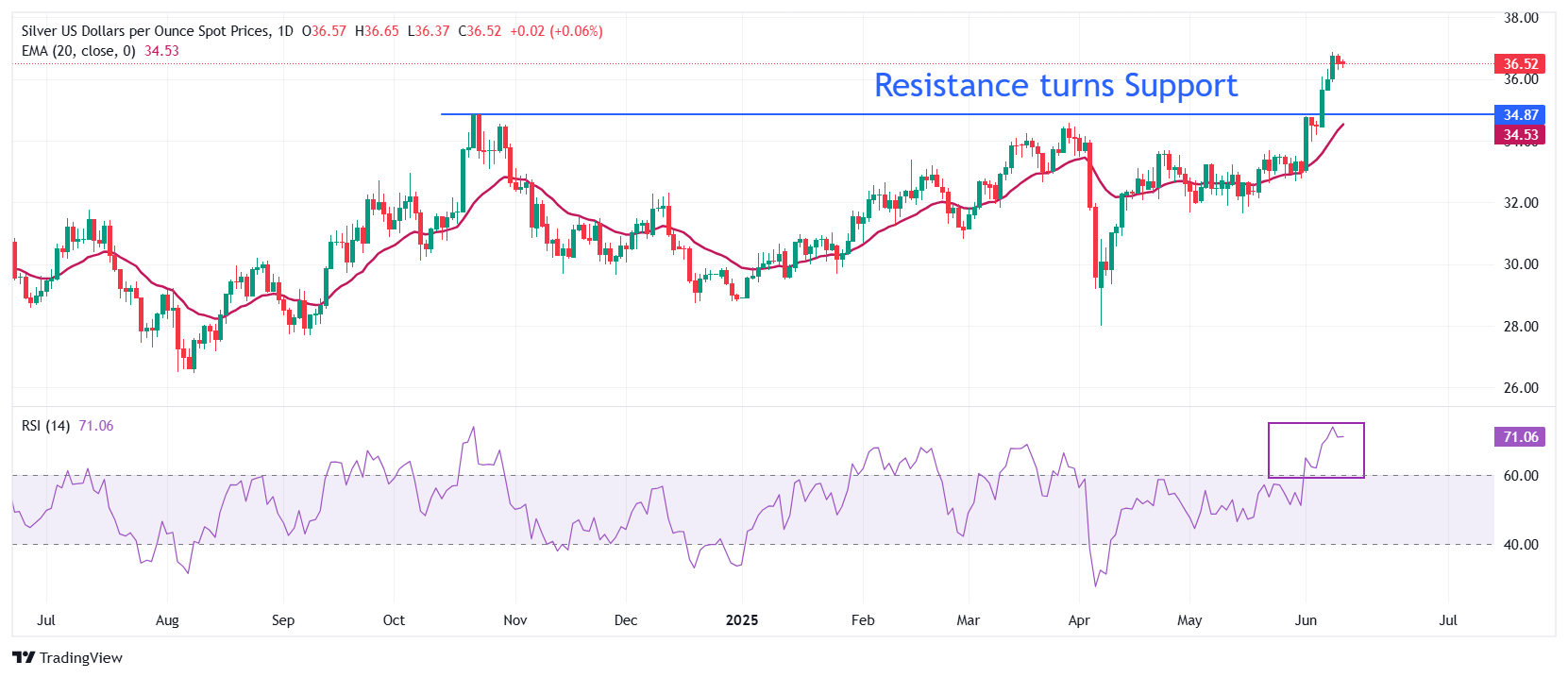- Silver price oscillates in a limited range around $36.50 ahead of the US inflation data for May.
- Signs of accelerating inflationary pressures would discourage Fed officials from endorsing early interest rate cuts.
- US Lutnick signals that both Washington and Beijing would ease export restrictions.
Silver price (XAG/USD) trades in a tight range around $36.50 during European trading hours on Wednesday. The white metal consolidates as investors await the United States (US) Consumer Price Index (CPI) data for May, which will be published at 12:30 GMT.
Economists expect the US headline inflation to have grown at a faster pace of 2.5% on year, compared to 2.3% in April. In the same period, the core CPI – which excludes volatile food and energy prices – grew by 2.9%, faster than the prior release of 2.8%. On month, the headline and the core CPI are expected to have grown by 0.2% and 0.3%, respectively.
The scenario of price pressures accelerating would allow Federal Reserve (Fed) officials to commit their stance of holding interest rates at their current levels long enough until they get clarity on how much new economic policies by US President Donald Trump will impact the economic and the inflation outlook.
Theoretically, the maintenance of a restrictive monetary policy stance by the Fed for a longer period bodes poorly for non-yielding assets, such as Silver.
Ahead of the US inflation data for May, the US Dollar Index (DXY), which tracks the Greenback’s value against six major currencies, ticks up to near 99.20.
On the global front, trade tensions between the US and China have eased after a two meeting in London. US Secretary of Commerce Howard Lutnick has expressed confidence that Washington will roll back export controls on sophisticated chips after China will reverse export restrictions on “rare earths”.
Historically, signs of easing global tensions diminish the appeal of safe-haven assets, such as Silver.
Silver technical analysis
Silver price rally pauses after posting a fresh over-a-decade high around $36.90. However, the near-term outlook of the white metal remains bullish as the 20-day Exponential Moving Average (EMA) slopes higher, which is currently around $34.50.
The 14-day Relative Strength Index (RSI) holds above 70.00, indicating a strong bullish momentum.
Looking up, psychological level of $40.00 will be the major resistance for the Silver price. On the downside, the October 22 high of $34.87 will act as key support for the asset.
Silver daily chart

Silver FAQs
Silver is a precious metal highly traded among investors. It has been historically used as a store of value and a medium of exchange. Although less popular than Gold, traders may turn to Silver to diversify their investment portfolio, for its intrinsic value or as a potential hedge during high-inflation periods. Investors can buy physical Silver, in coins or in bars, or trade it through vehicles such as Exchange Traded Funds, which track its price on international markets.
Silver prices can move due to a wide range of factors. Geopolitical instability or fears of a deep recession can make Silver price escalate due to its safe-haven status, although to a lesser extent than Gold’s. As a yieldless asset, Silver tends to rise with lower interest rates. Its moves also depend on how the US Dollar (USD) behaves as the asset is priced in dollars (XAG/USD). A strong Dollar tends to keep the price of Silver at bay, whereas a weaker Dollar is likely to propel prices up. Other factors such as investment demand, mining supply – Silver is much more abundant than Gold – and recycling rates can also affect prices.
Silver is widely used in industry, particularly in sectors such as electronics or solar energy, as it has one of the highest electric conductivity of all metals – more than Copper and Gold. A surge in demand can increase prices, while a decline tends to lower them. Dynamics in the US, Chinese and Indian economies can also contribute to price swings: for the US and particularly China, their big industrial sectors use Silver in various processes; in India, consumers’ demand for the precious metal for jewellery also plays a key role in setting prices.
Silver prices tend to follow Gold’s moves. When Gold prices rise, Silver typically follows suit, as their status as safe-haven assets is similar. The Gold/Silver ratio, which shows the number of ounces of Silver needed to equal the value of one ounce of Gold, may help to determine the relative valuation between both metals. Some investors may consider a high ratio as an indicator that Silver is undervalued, or Gold is overvalued. On the contrary, a low ratio might suggest that Gold is undervalued relative to Silver.

